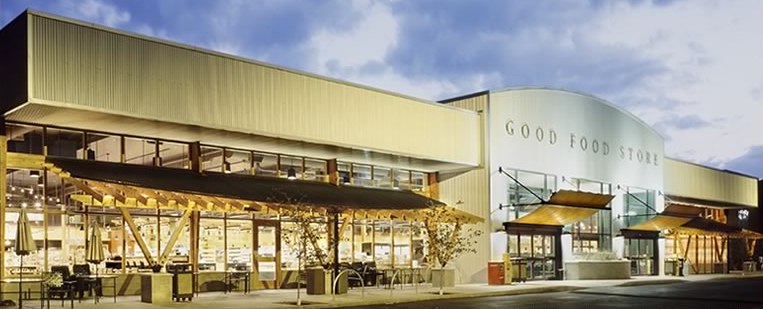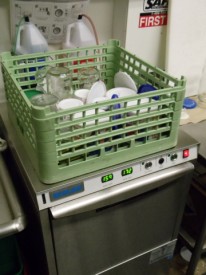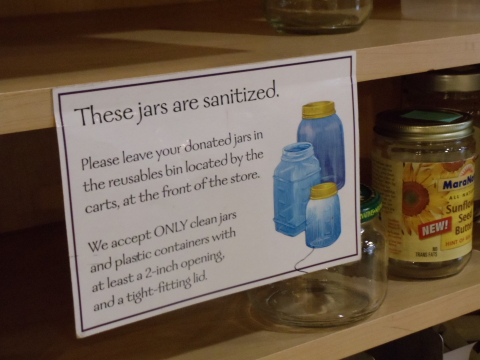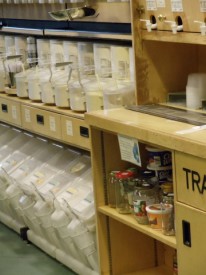
You’ve heard about the Great Pacific Garbage Patch and seen Chris Jordan’s shocking photos. Maybe you have even heard that the plastic in the oceans outweighs plankton six to one (at least, the nonwater-parts of the plankton and in some parts of the oceans). But have you heard about the elegantly simple solution lived out daily at Missoula, Montana’s Good Food Store?
It’s called a sanitizer: think of it as a dishwasher that uses heat instead of soap. The Good Food Store, a grocery store, employs one to sterilize used yogurt tubs, pickle jars, and other containers, then puts them out for customers to refill.
Yes, a po-dunk grocery store in Montana, aka, eastern Cascadia, is leading the way with its understated solution to a Cascadian and global problem. (Full disclosure: your author is a Griz.)

According to a 2010 report by the US Environmental Protection Agency, containers and packaging constitute the largest product category of municipal solid waste generated in the country. They account for 30 percent of all solid waste, nearly 76 million tons. That’s a lot of yogurt tubs.
Salt on wounds: only 48 percent of those materials are recycled! Any third grader can tell you that “recycle” is a mere runner up to “reduce” and “reuse” in the hierarchy of virtues.
According to the EPA, manufacturing new plastic from recycled plastic requires two-thirds of the energy used in virgin plastic manufacturing. A nice graphic illustrating the benefits of reusing over recycling, with computers as an example, is here.
How can we whittle away at the enormous mountains of packaging waste? By improving the policies around reusing refillable containers.
Layne Rolston, communications director for the Good Food Store says he believes his store is unique in the United States in allowing sterilization, sharing, and refilling of customer containers. The store has been doing it for years and has effectively been grandfathered in. “If we tried starting it from scratch now,” Rolston says, “we probably couldn’t do it. But the [Missoula City/County] Department of Health has been very supportive. They realize it’s one step in reducing environmental impact, and they want us to continue the practice.”
I’ve asked around and haven’t found a single store in Oregon or Washington
that offers on-site washing and reuse of containers. (I haven’t checked in British Columbia or elsewhere in Cascadia. Do you know of one? Let me know in comments!)
“We’re the only store that I know of that does this,” says Rolston. “I’ve heard of other places trying around the country, but they all get shut down. Health departments don’t like the idea.”

The reason Good Food’s sterilizing dishwasher is so lonely? Phil Wyman, code enforcer
for Seattle-King County Public Health, points to a cluster of nearly nationwide regulations about food containers that prevent in-store reuse. You can peruse them here. (The color-coding reflects proposed amendments and changes. The state of Washington is currently reviewing amendments to Chapter 3-304.17C, which requires that when seeking a refill of your coffee in your paper cup, vendors are REQUIRED to throw that cup away and give you a new one. The proposed change will allow them to reuse that cup.)
The real culprit is “Chapter 4-603.17: Returnables, Cleaning for Refilling. . . . returned empty containers intended for cleaning and refilling with FOOD shall be cleaned and refilled in a regulated FOOD PROCESSING PLANT.” It prohibits grocery stores, coops, and other food institutions from doing what the Good Food Store does: sterilize reusable containers for their customers to, um, actually reuse.

What does it take to change this? Well, any jurisdiction can adopt its own rules, but as Wyman explains, the normal US process is for changes to flow from the federal government: the US Food and Drug Administration releases its “Model Food Code” every four years. That recommended food code then works its way out through policymaking bodies across the United States. State food-code boards review the model, add their own amendments, and then pass the code down to local jurisdictions to do the same. The whole process takes about four years. So, for example, the Seattle/King County Public Health adopts its 2009 food code just in time for the FDA to adopt its brand new 2013 model code.
Though it may sound bureaucratically comical, the process does have its merits, and it’s punctuated every two years with the Conference for Food Protection, which “brings together representatives from the food industry, government, academia, and consumer organizations to identify and address emerging problems of food safety and to formulate recommendations.”
And who decides what an “emerging problem” is? Anyone! Anyone can submit proposals to the conference. The bad news: the submission period for this year’s conference closed January 5th. For the current conference, the Pennsylvania Department of Agriculture’s Bureau of Food Safety submitted an issue addressing some of the environmental absurdities of 4-603.17 (“Reuse-Refill of Multi-use Tableware (To go containers)”), but not the whole “sterilizing must take place in a food processing plant” part. That will have to wait until the 2014 conference. Alas, it won’t be until December of 2013 before the submission period opens. Forms and instructions will be found on the Conference for Food Protection’s website. Fortunately, the group’s executive director thinks that allowing commercial facilities, not just food processing centers, to sterilize reusable containers has merit and would be something the conference would consider.
Even then, there’s no guarantee that the reusing-pickle-jars proposal will win the conference’s support, nor that it will become part of the FDA’s 2015 model food code, nor that Cascadian jurisdictions will adopt that section of the 2015 model code.
So, in the meantime, any jurisdiction can follow Missoula’s lead and adjust its rules to allow sterilization of consumer containers on-site. The FDA’s model food code is just federal advice. Localities set their own rules. You can help by sending a letter—or a yogurt tub—to the FDA or your local health department. Check these sites to get started: Washington, Oregon, or Seattle/King County (or specifically, the King County Food Protection Program).
While the policy fight unfolds, if you want to see the simplest solution to the Great Pacific Garbage Patch, you can stockpile your containers and take a trip to Missoula, Montana’s Good Food Store. If you call ahead, they may even show you their fancy dishwasher.
Chris LaRoche recently graduated with a Master’s in Public Administration from the Evans School of Public Affairs at the University of Washington, where he focused on developing community solutions to climate change, sustainability, and de-carbonizing the global economy. His previous incarnations include an inner-city school teacher, Spanish language translator, and organizer for interesting community endeavors.
All photos courtesy of the Good Food Store, Missoula, Montana.

Comments are closed.